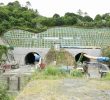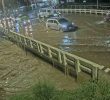Clad in their traditional garb as they joined some 5,000 people from the different towns of Compostela Valley and Davao Oriental, they asked, where is the government? And where is its promise of genuine relief and rehabilitation?
By KENETTE JEAN I. MILLONDAGA
Davao Today
MONTEVISTA, Compostela Valley, Philippines – Resilient. That’s how they have remained after almost 10 hours of staying under the sun and the rain, and with little food and water.
Women from different indigenous communities in the Davao Region have walked for hours from the mountains and travelled for more hours to join the barricade on Tuesday, January 15 at the Montevista National Highway in Compostela Valley, nearly a three-hour ride by land from Davao City.
Clad in their traditional garb as they joined some 5,000 people from the different towns of Compostela Valley and Davao Oriental, they asked, where is the government? And where is its promise of genuine relief and rehabilitation?
Christine, from the Matigsalog tribe in Bermuda village, Compostela town, told davaotoday.com that they have mustered all their strength and will to rise above the situation after typhoon Pablo ravaged their community.
She said that just two weeks before Pablo, they harvested their upland rice which they stored in their lalapong, a traditional storage facility that’s made of wood and nipa, the Matigsalog’s way of storing their newly harvested upland rice and seedlings which is usually built away from their houses to protect the seedlings from rat and other animal infestation.
“When the morning came and the rain had stopped, we immediately checked our lalapong if the seedlings are still safe,” she said. “But they were destroyed by the typhoon,” she lamented.
All other family members and the neighborhood who were able to salvage some seedlings, washed them and dried. “We gathered everything that we saved. It was about a half sack of rice which we used for our communal farming,” Christine shared.
“Had we relied on the government, we would have already died from hunger. Right now, the seedlings we have planted are already growing,” she said.
She said that they heard over the radio that donations for the Pablo victims from private agencies, government offices and international agencies are teeming. “But where is it?” she asked.
The Indonesian government has reportedly given 40,000 kilograms of foods, blankets and medicines and over PHP 40 million grant to the Philippines last December. It turned over 1.7 million Kg of rice over the weekend. The United States said it has given over PHP 500 million-worth total assistance to the Pablo victims as well as 2.1 million Kg of rice. Boxing champ and Sarangani Representative Manny Pacquiao also distributed PHP 10 million worth of assistance.
Christine said they had to walk for four hours just to get their ration of two kilos of rice per relief operation. Thus, they had to wait for two weeks to get the relief in bulk which include 16 kilos of rice, five cans of sardines, six packs of noodles and three cans of beef loaf.
“We have to do that to lessen the burden of walking and evade the dangers of passing through the rivers,” she said.
Meanwhile, Letty from the Mandaya tribe in New Visayas town criticized the government’s system of relief distribution. She said that the much-hyped media noche handouts before New Year were not distributed evenly among the supposed recipients.
“For example, they only gave one food pack to a house where three families are staying because others have no more place to stay,” she said, adding that “Ang relief pinilian na daan. Maayo pa ang trapo ani. Putol na ang kamot, putol na ang tiil sa mga sinina nga among madawat nga gikan sa munisipyo (The clothing relief goods that come to our hands from the municipal hall are good as throwaways. The sleeves are either torn, the hems cut).”
Reneng, from the Manguiangan tribe in Monkayo called herself a “bakwiter” (evacuee) as she and her family evacuated from their home after Pablo. She said it was impossible for them to erect a temporary shelter in their area.
“Wala mi nalista sa purok kay gikan man mi sa Monkayo. Pareho lang man mi nga mga biktima. Nganong dili man ko nila iapil sa listahan nga imposible man gyud makapatukod og balay didto sa among lugar (We were not in the list because we are from Monkayo. We are also victims. Why wouldn’t they include us when we could not really afford to put up a house?),” she said.
Irene, from Salvacion, Monkayo also lamented the distribution of materials for their temporary shelter such as tents, hammers, pails and nails.
“Not all of us received (the materials) even when our names are on the list. The DSWD (Department of Social Welfare and Environment) issued a ticket for those whose names appeared in the list, but we have not received anything. They said they already ran out of ticket,” she shared.
Women victims also complained against the DWSD’s program of food and cash for work.
Letty said that men selected to work for cash were promised of PHP 225 per day. However, the amount, she said, will only be given after a 10-day work. Workers were also promised to get five kilos of rice per day but they can only claim it after their work equivalent will reach 50 kilos or one sack of rice.
“Unta ihatag na pod sa uban ang trabaho inig human na sa 10 ka adlaw kay gusto man pod makakwarta ug hatagan og higayon ang uban nga maka-trabaho (We hope they will also give others the chance to work after 10 days so that they can also earn something),” Vilma, a Mandaya from ComVal lamented as she criticized that those who are selected for work are close to the village officials. (Kenette Jean I. Millondaga/davaotoday.com)










